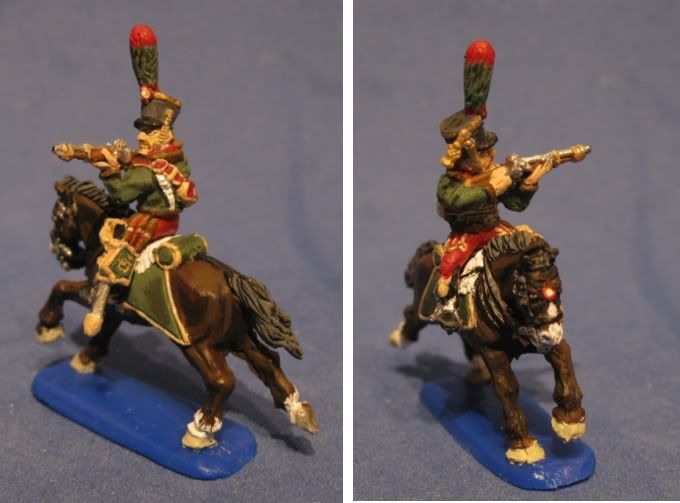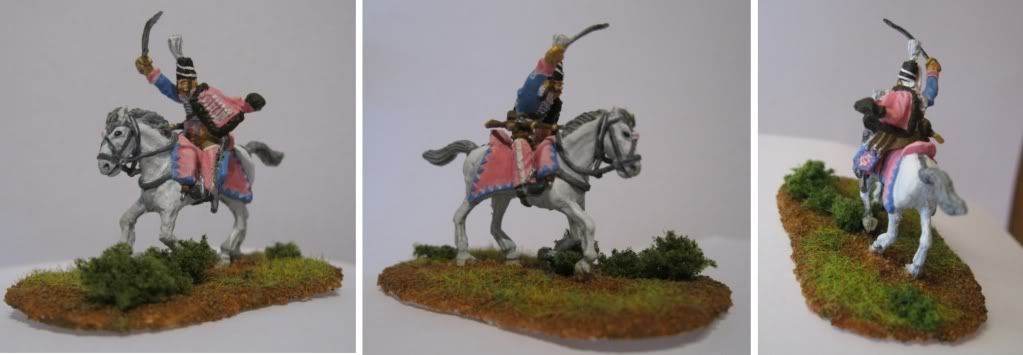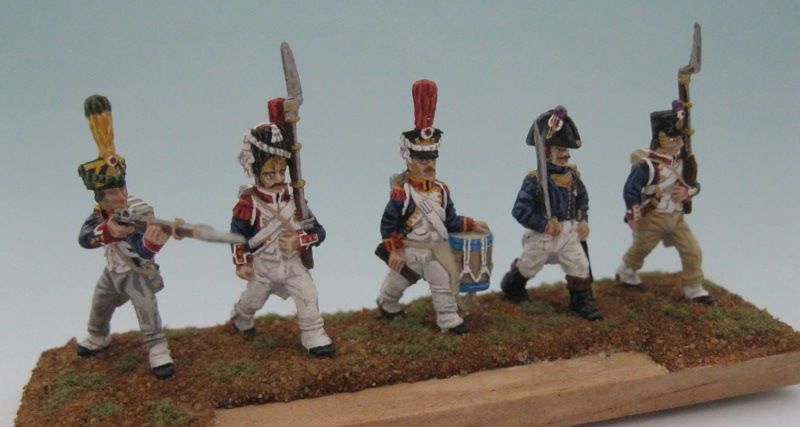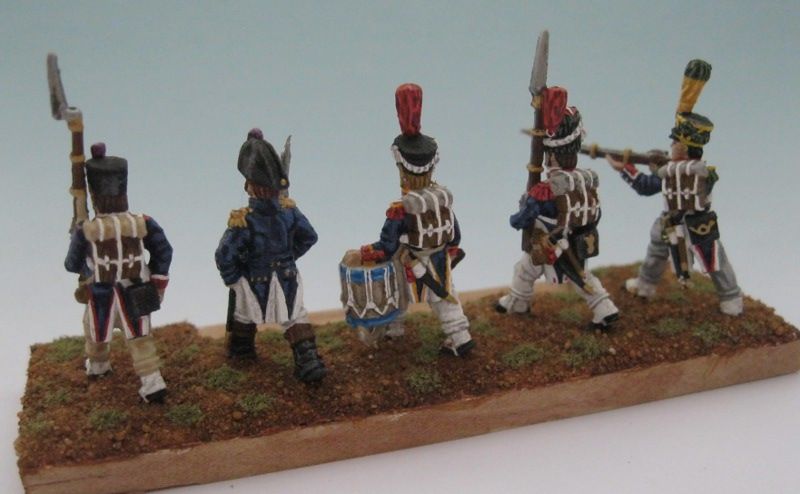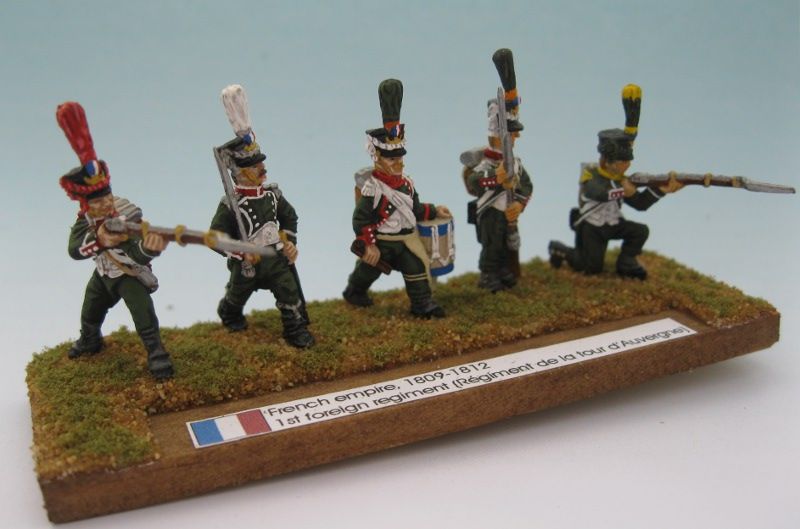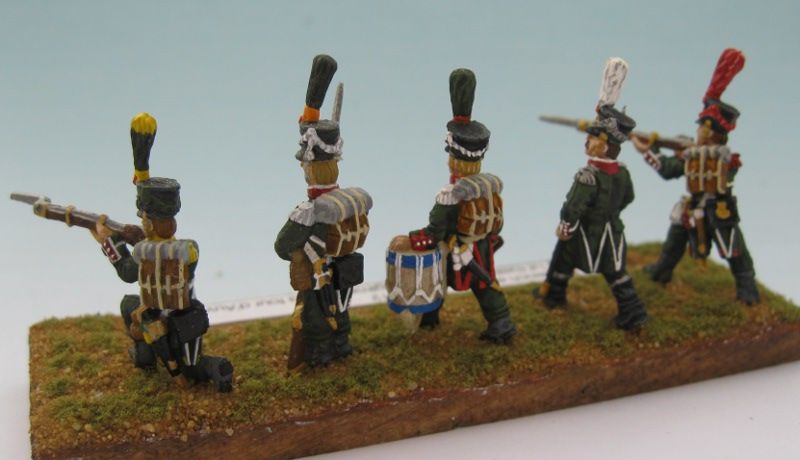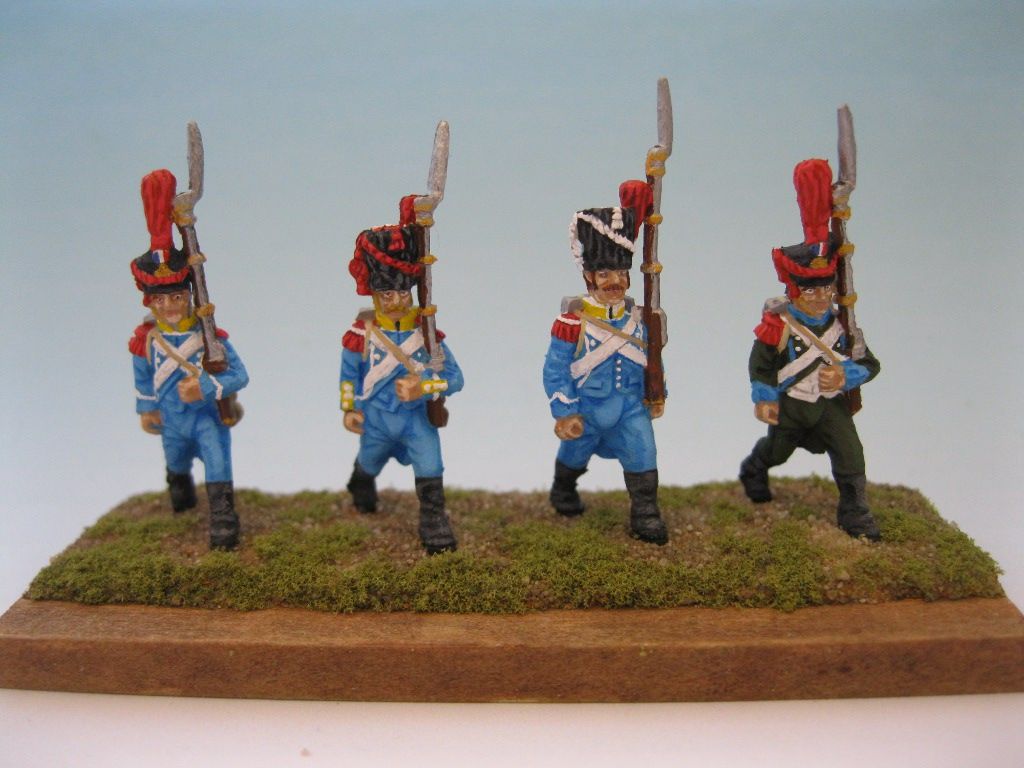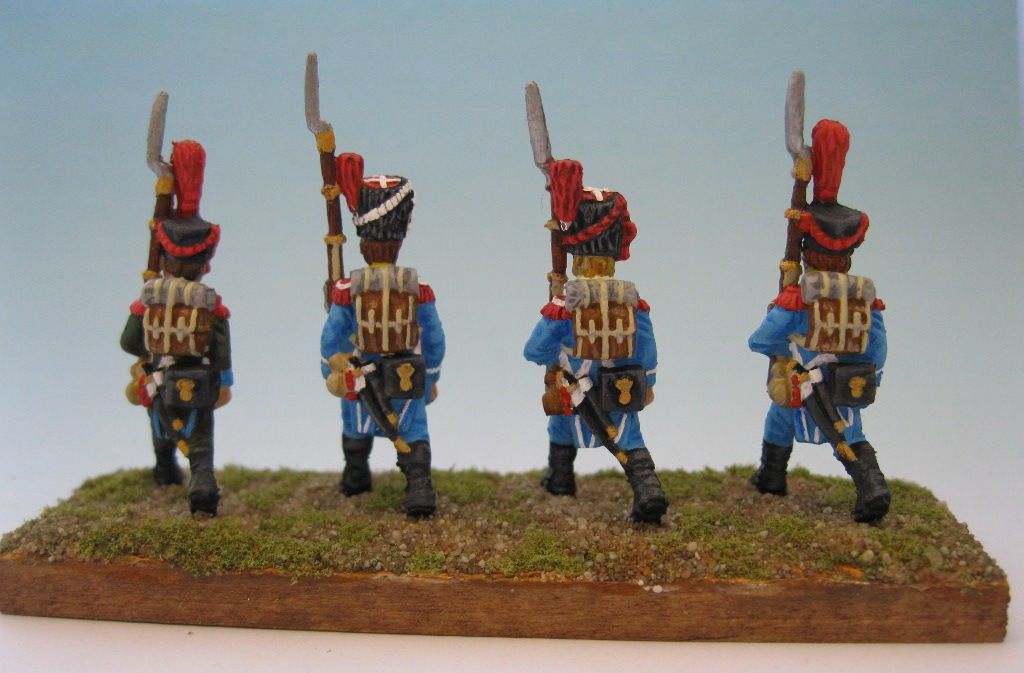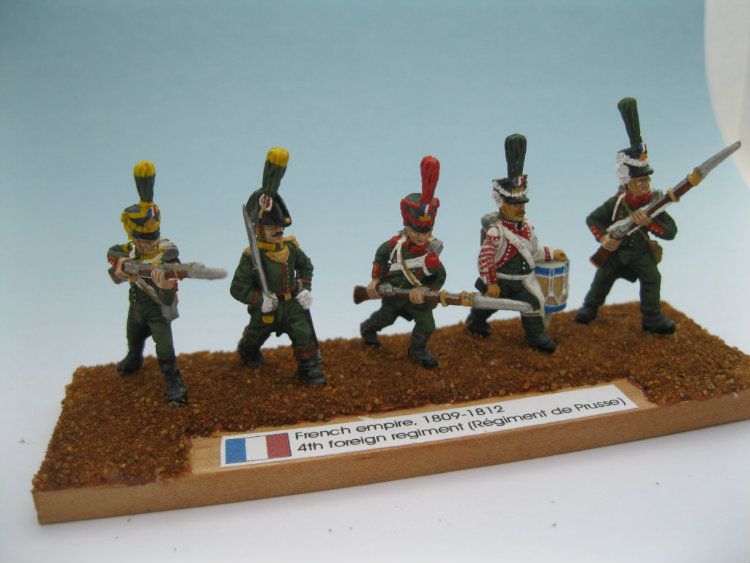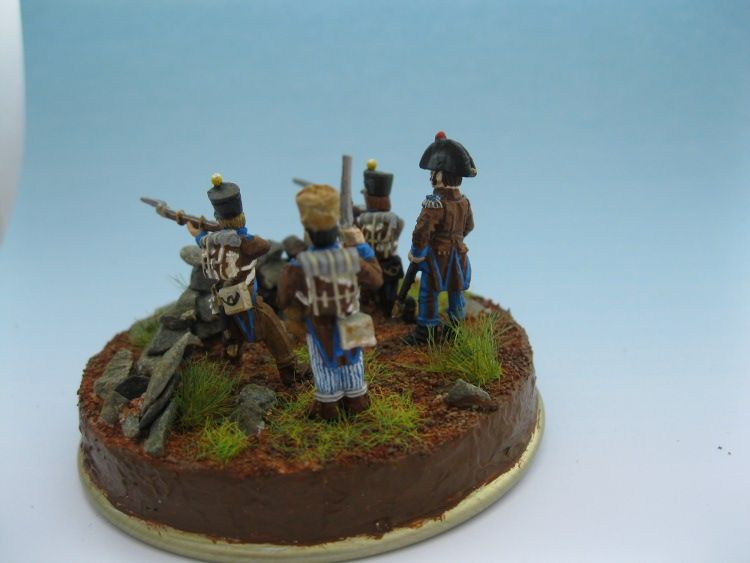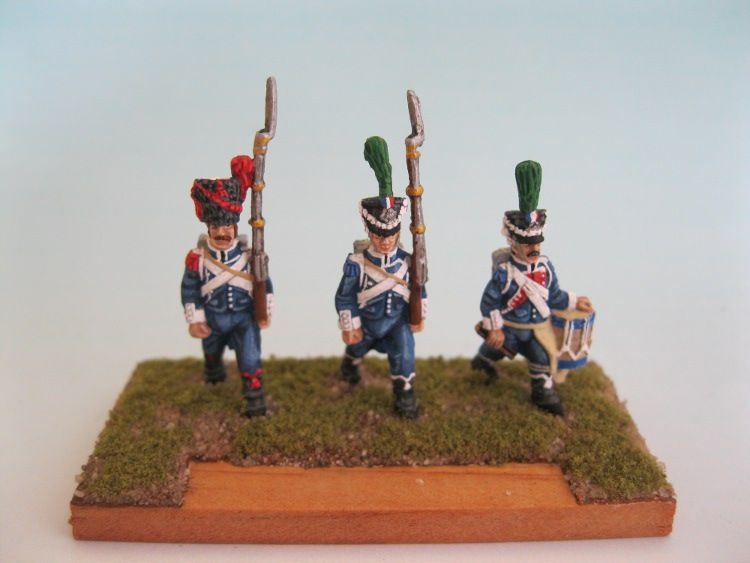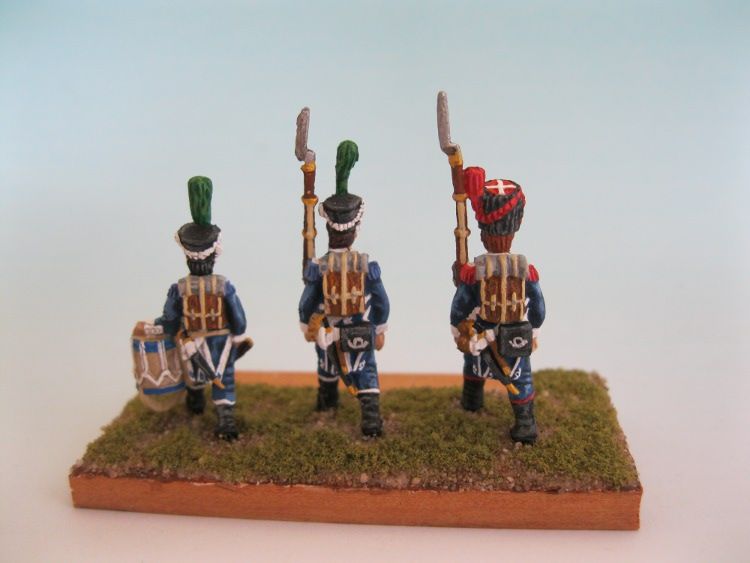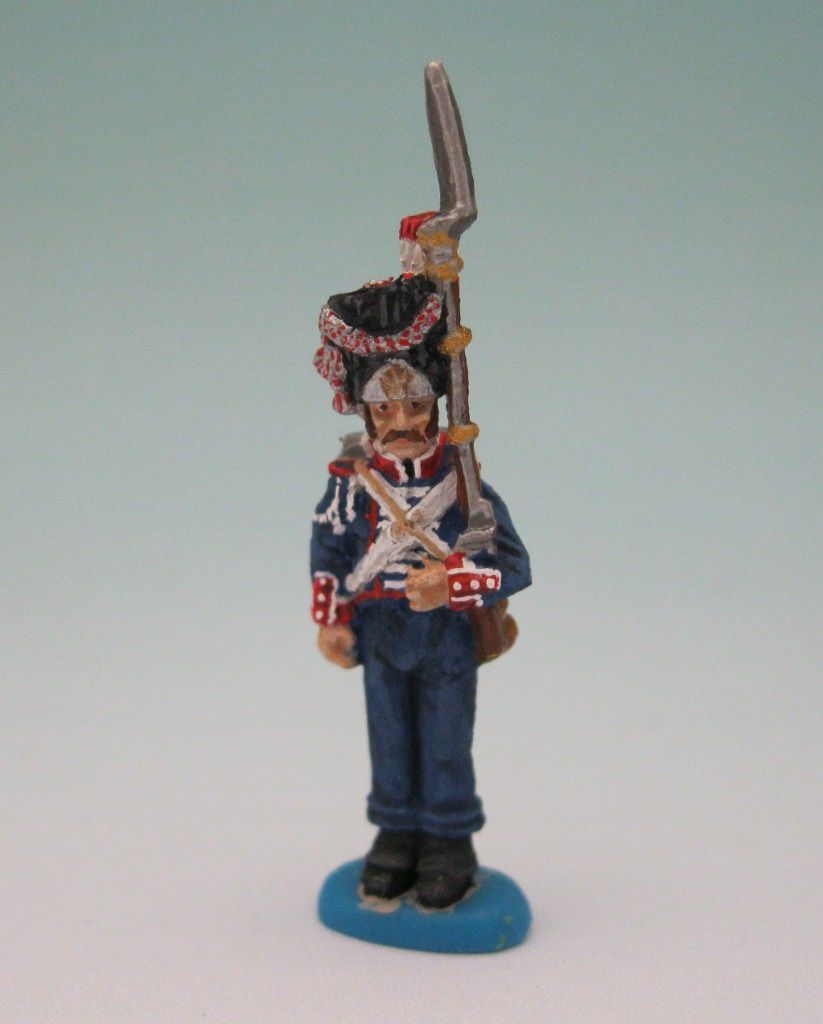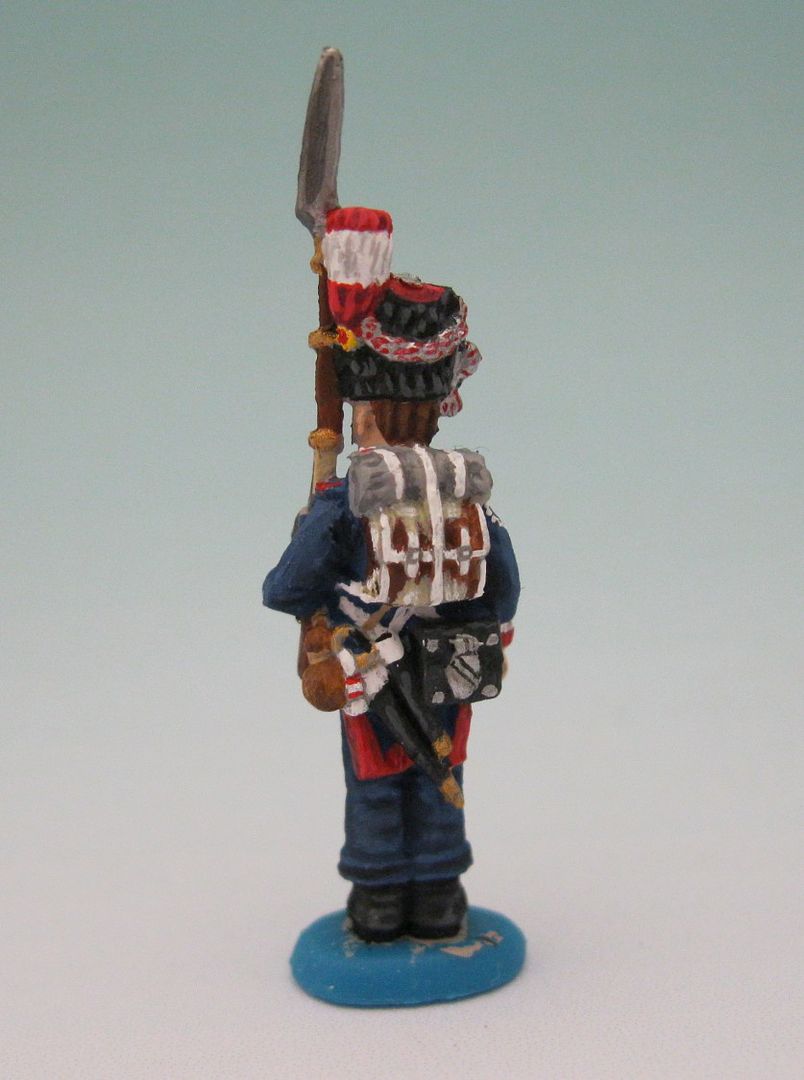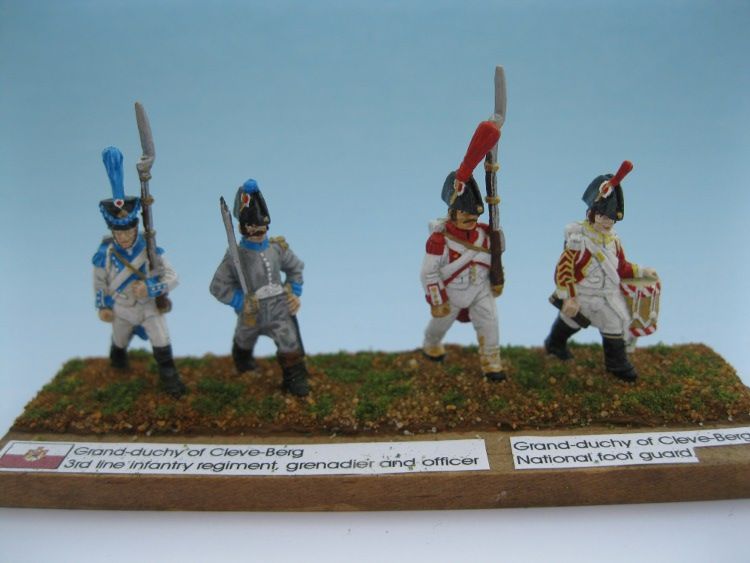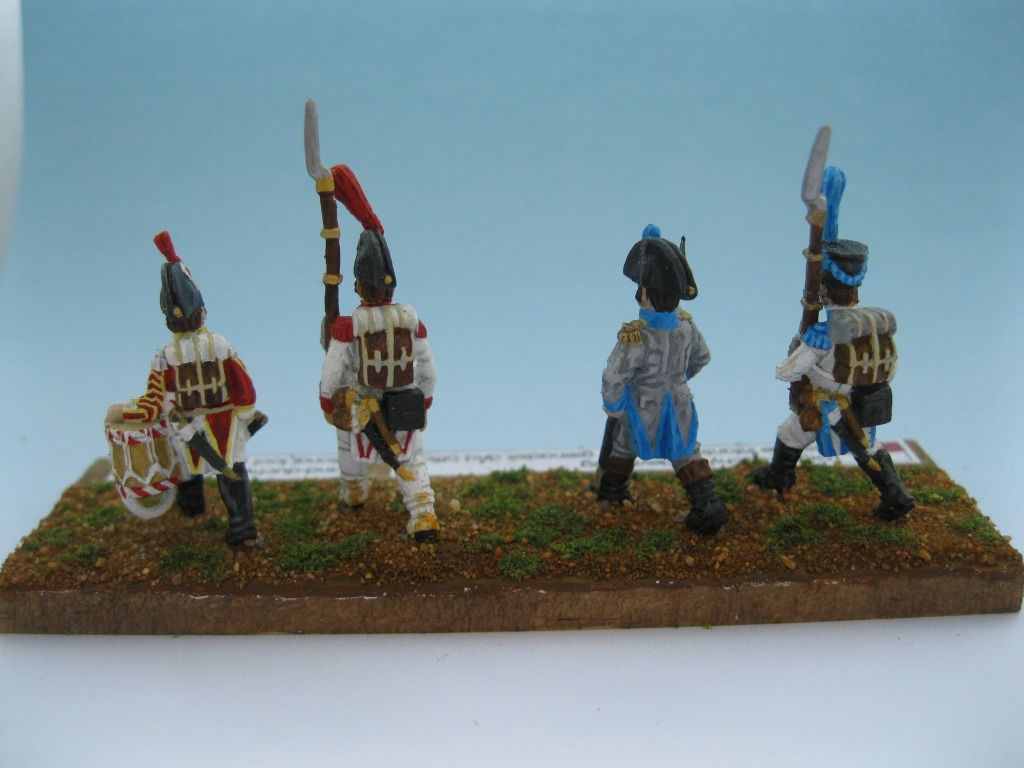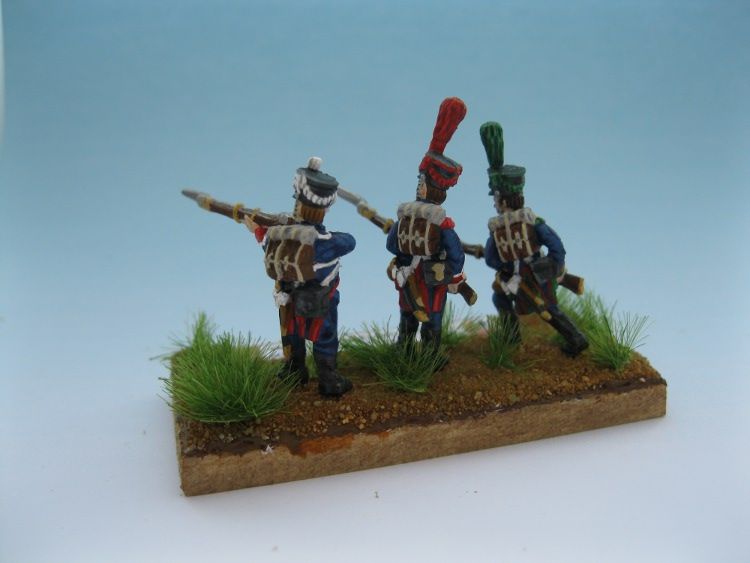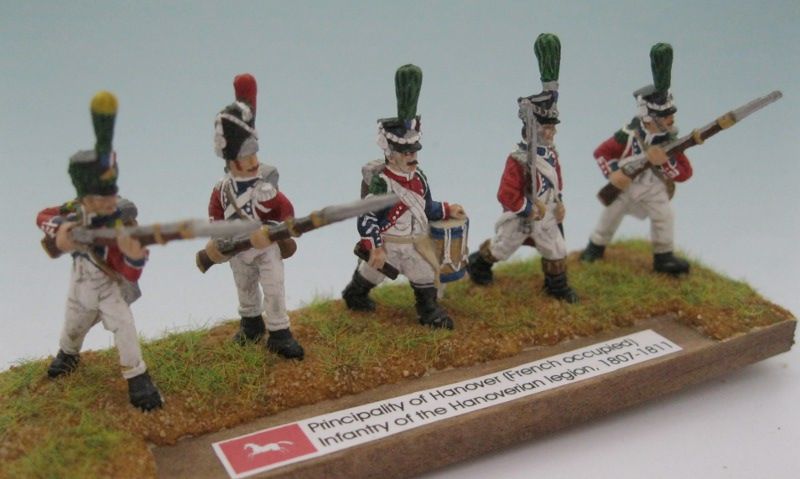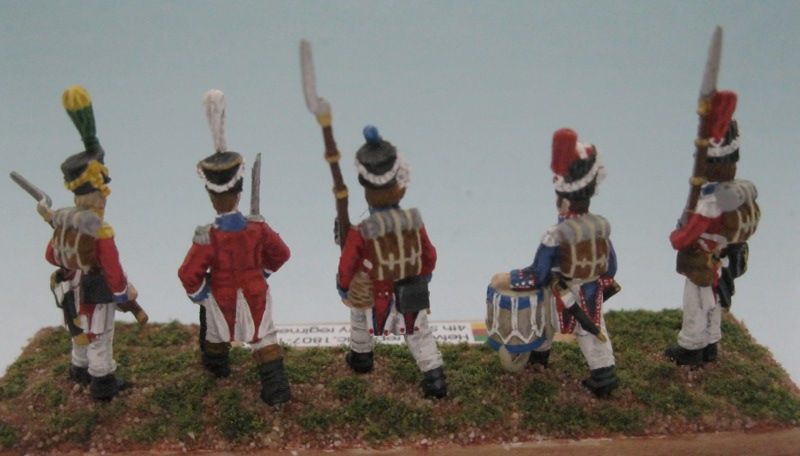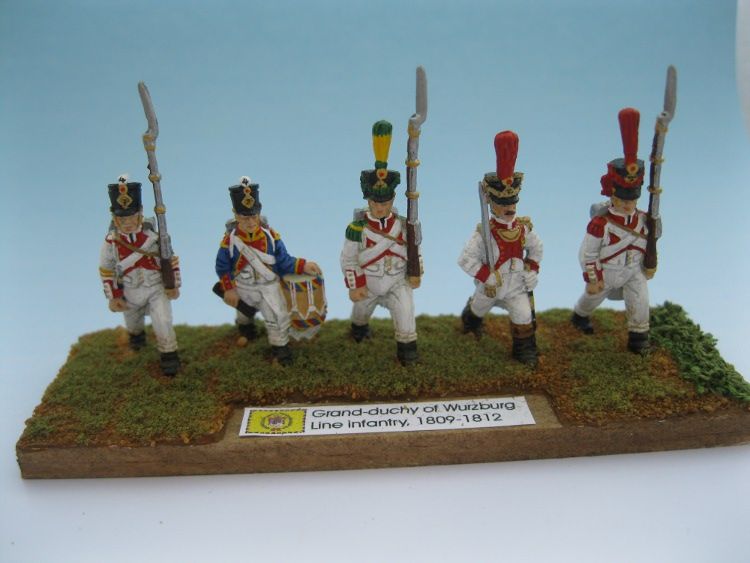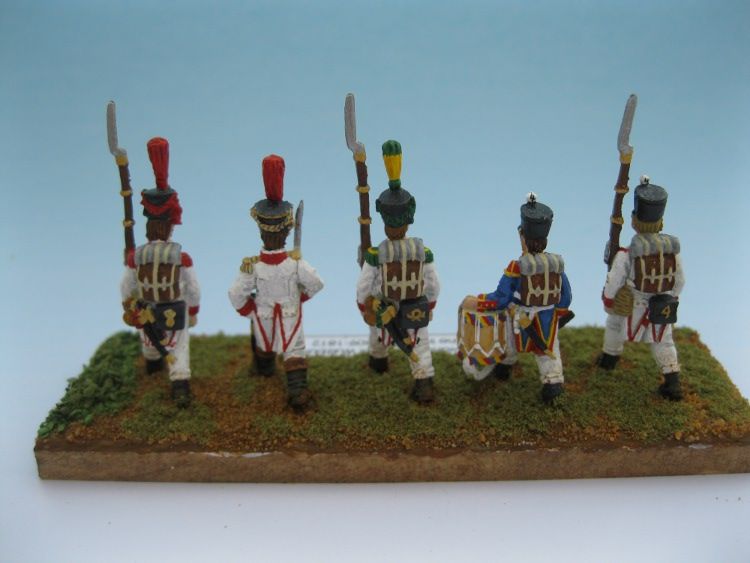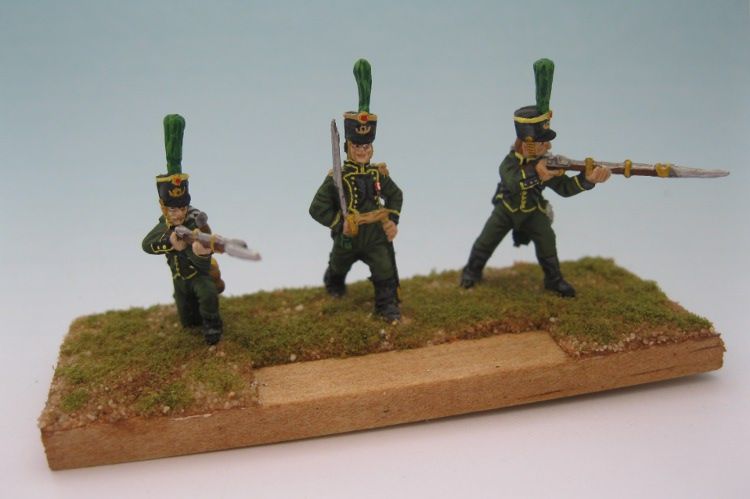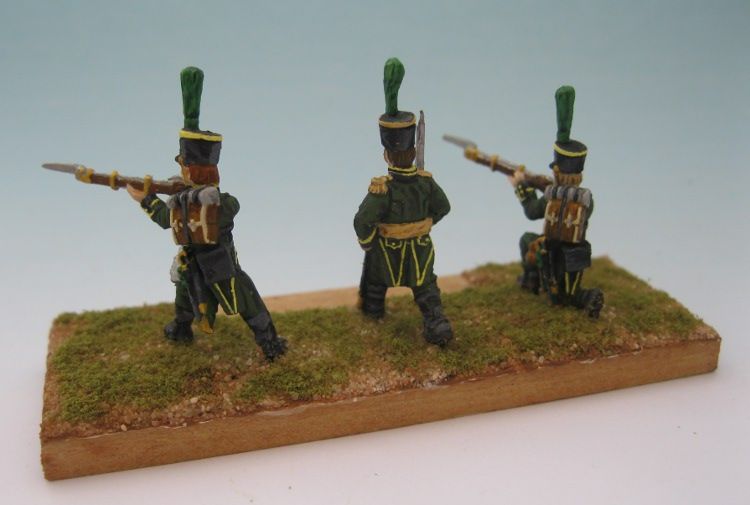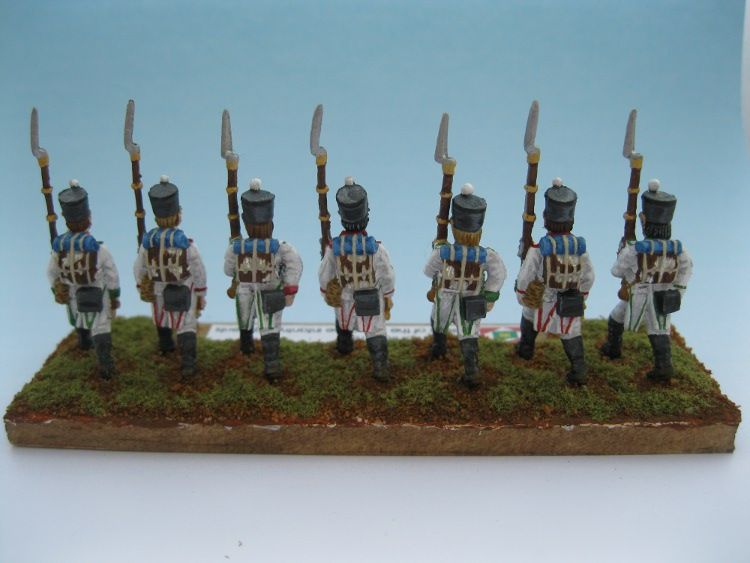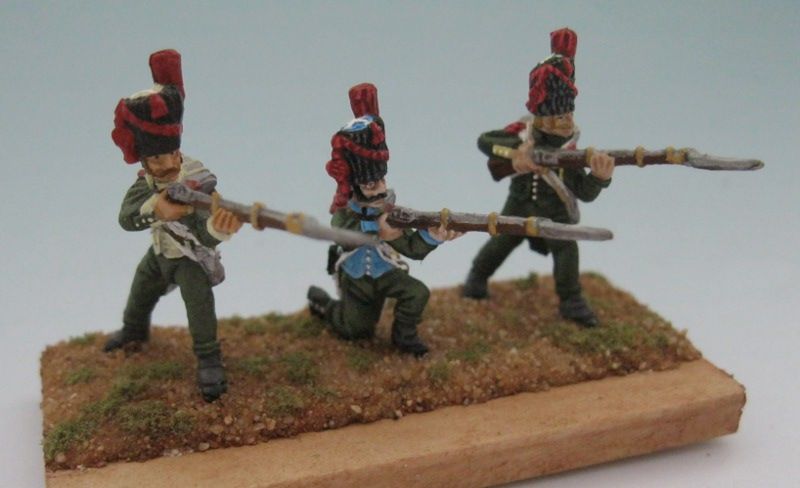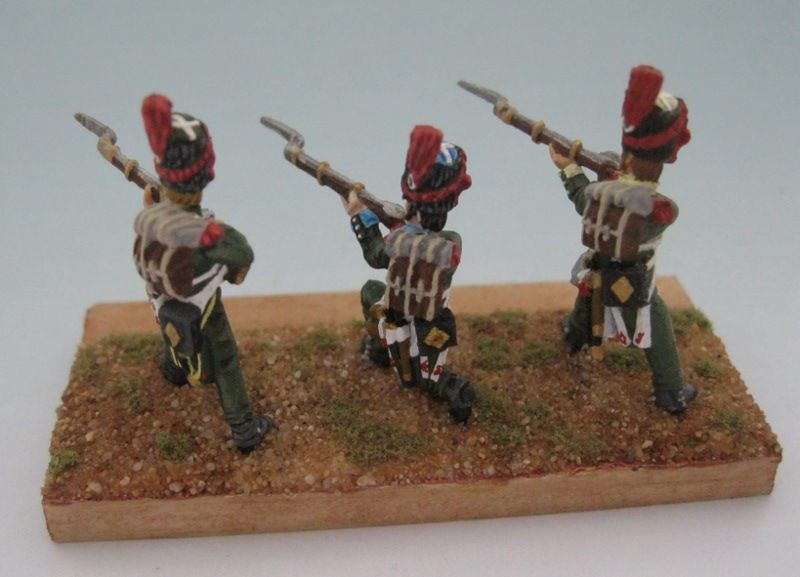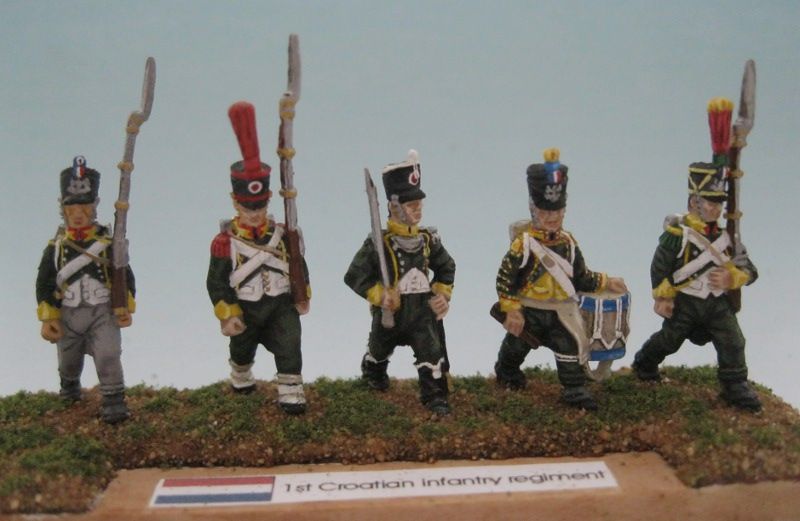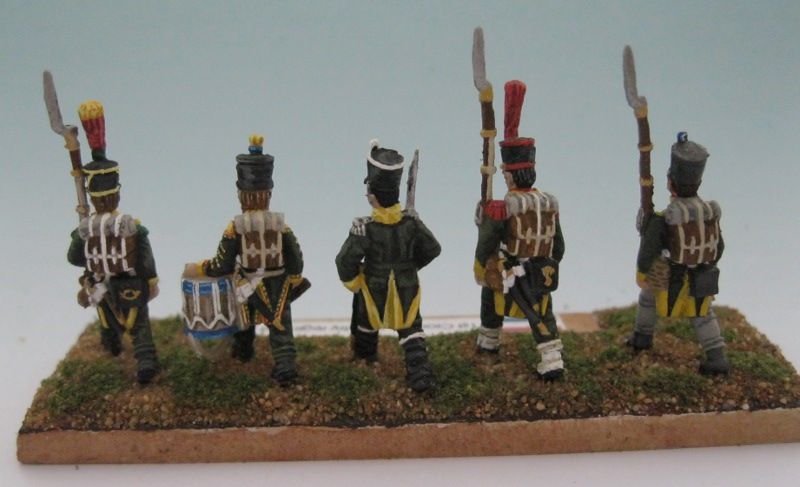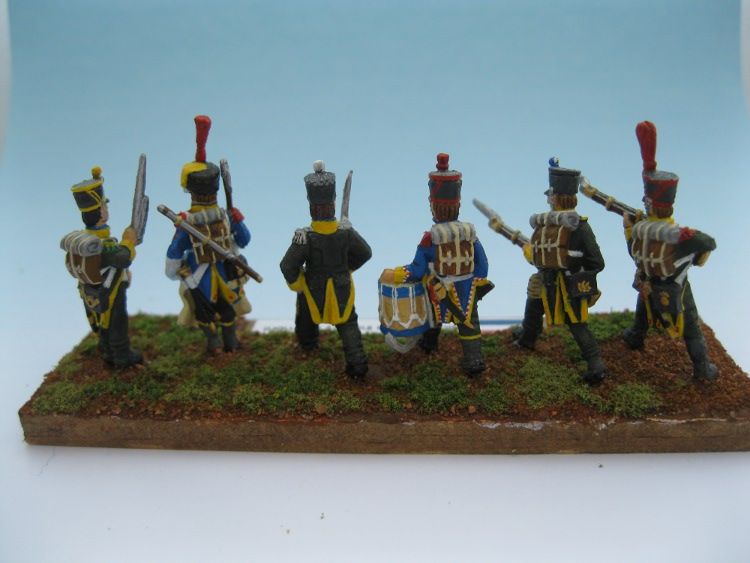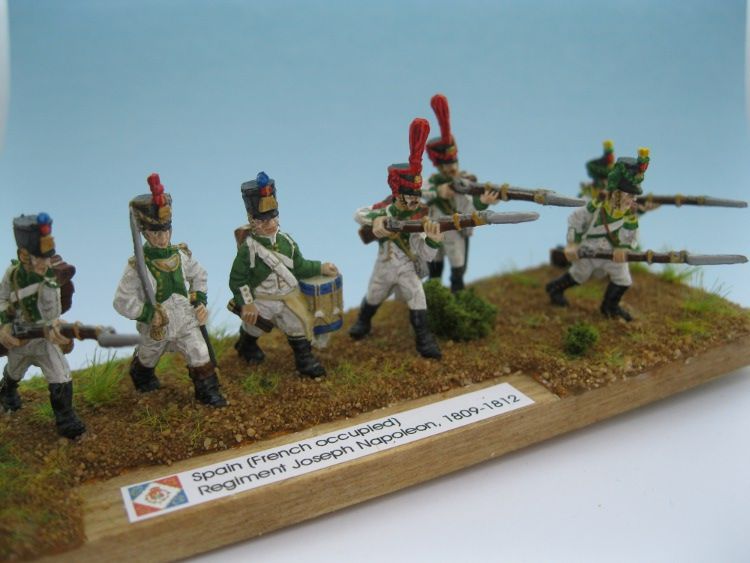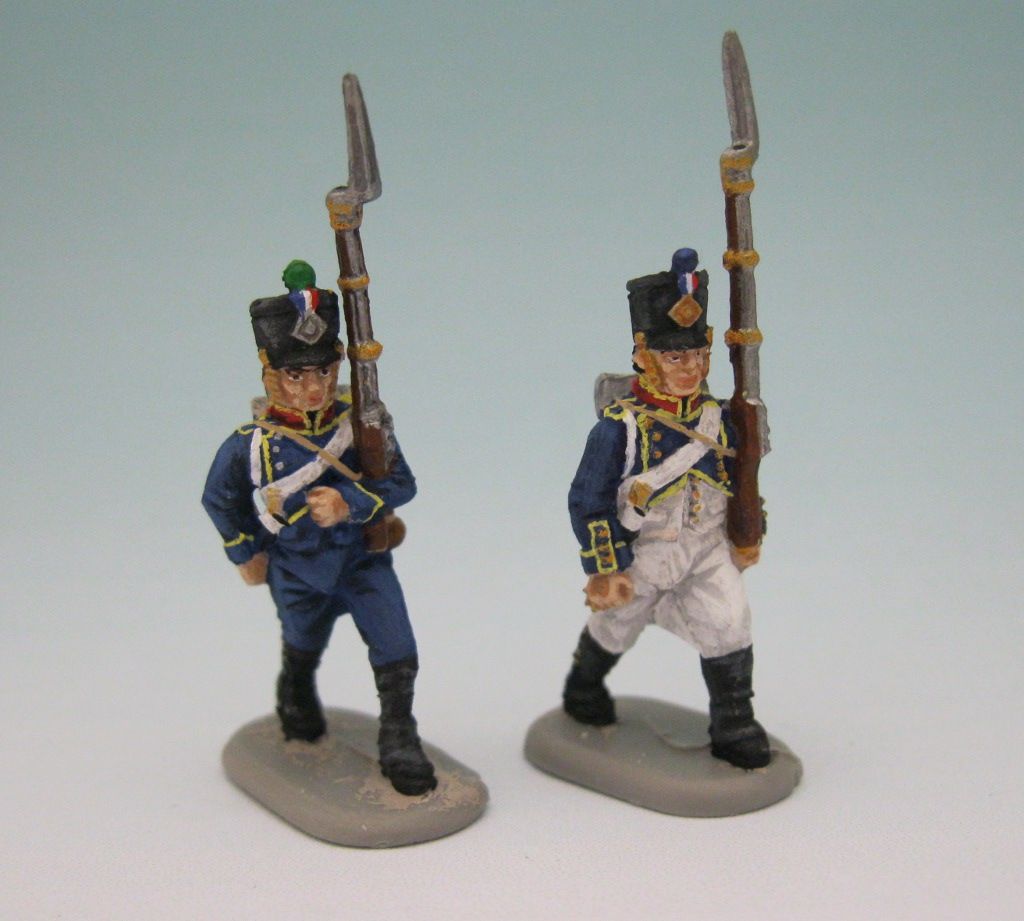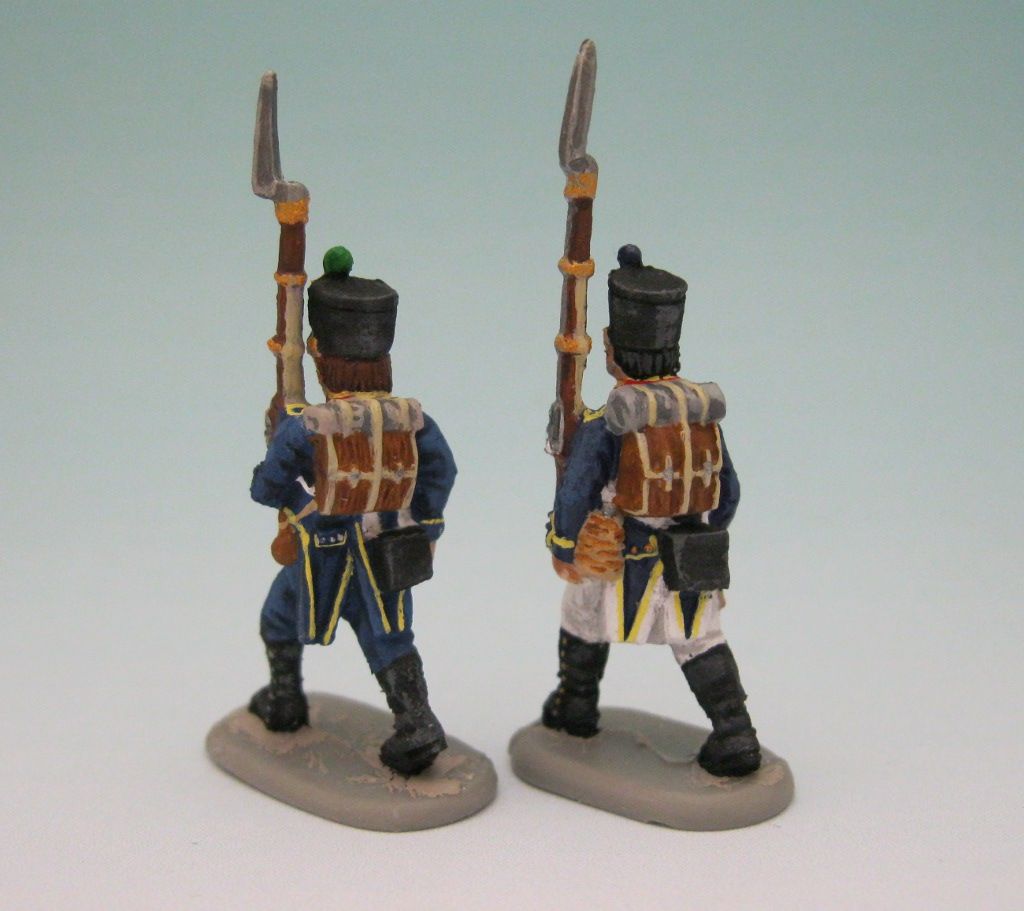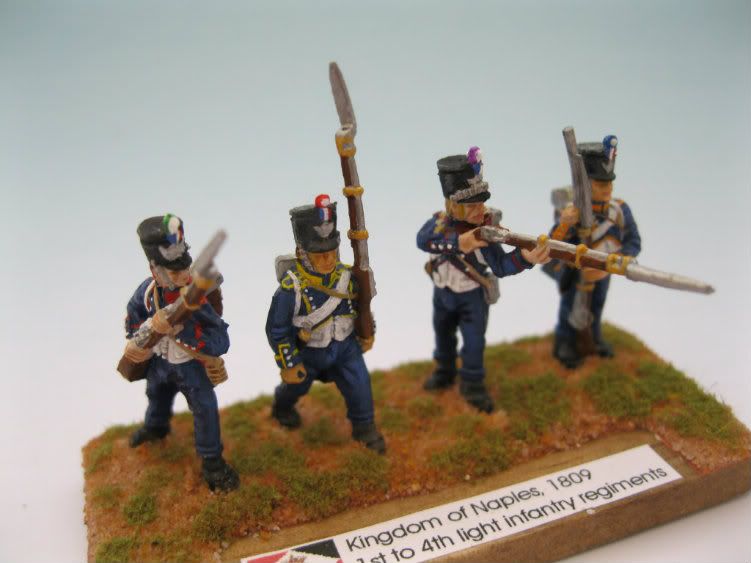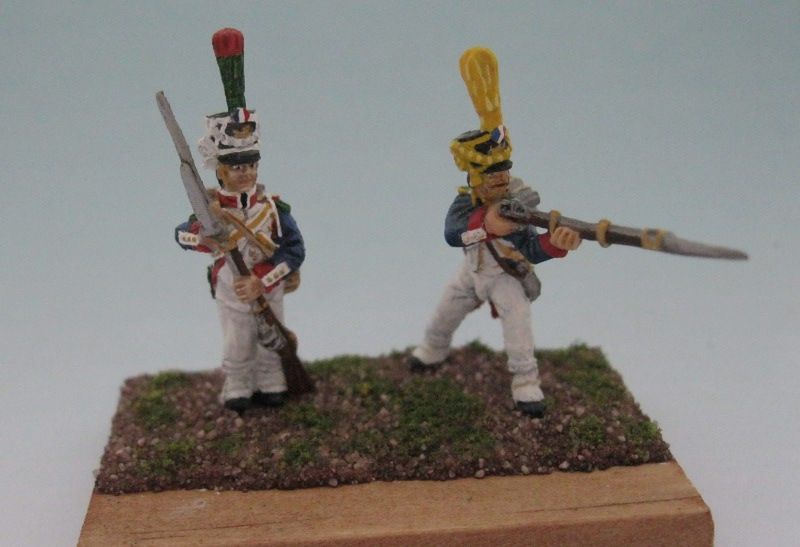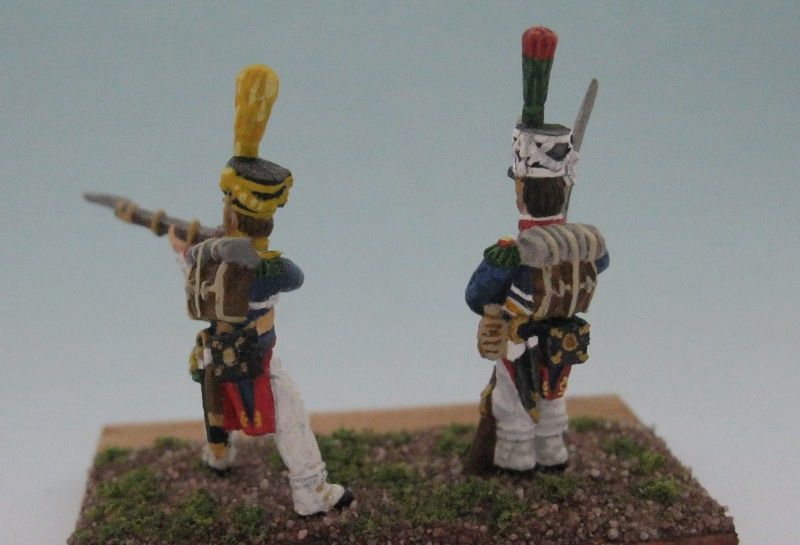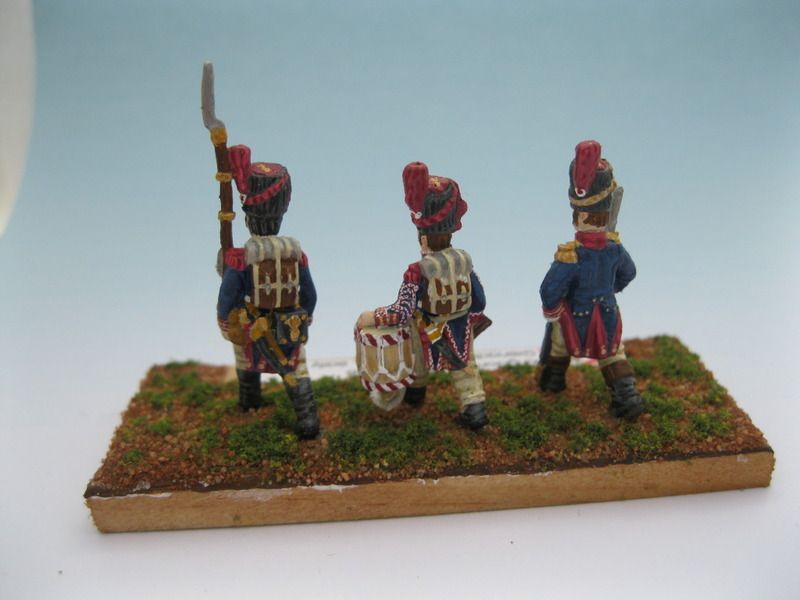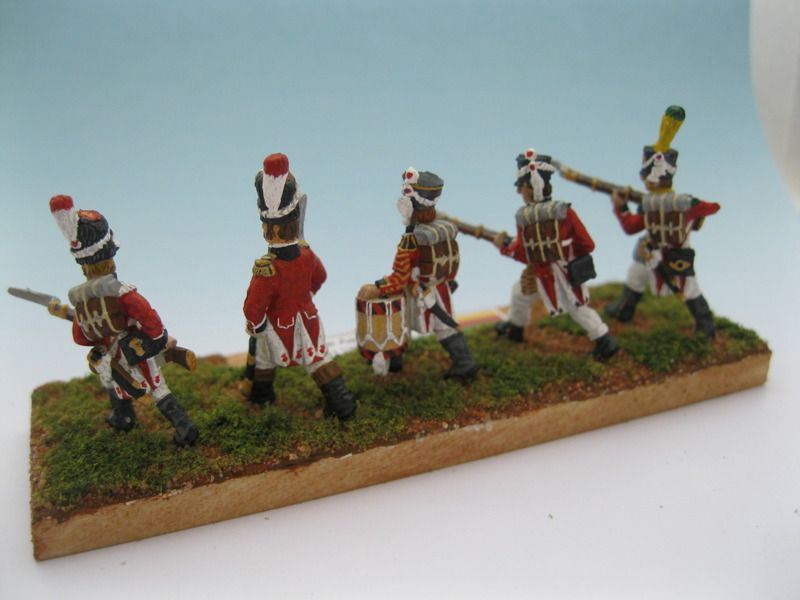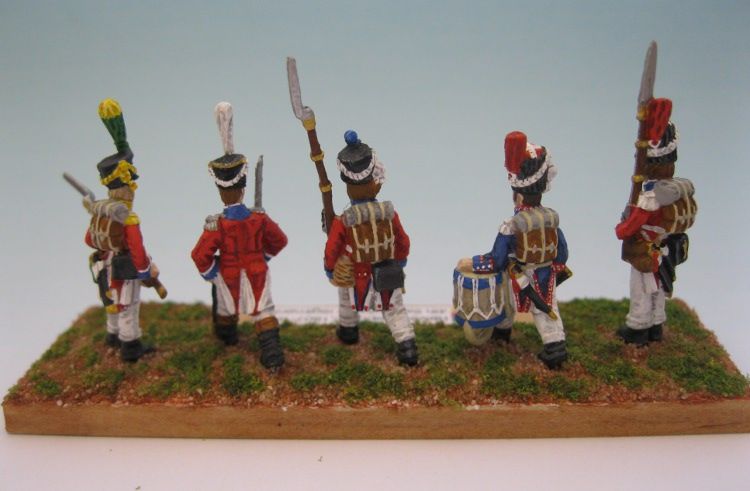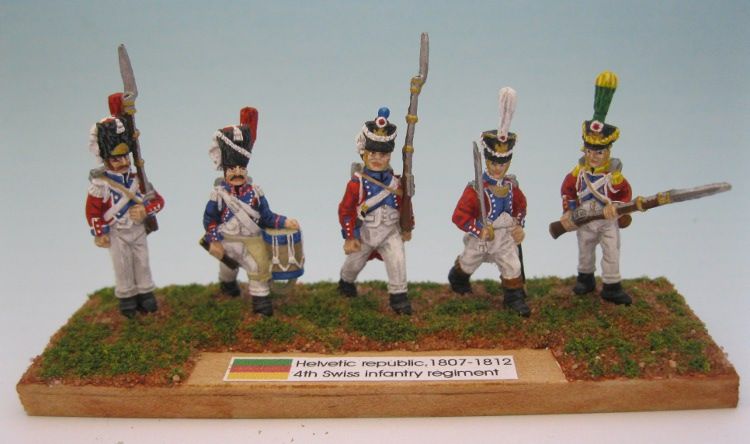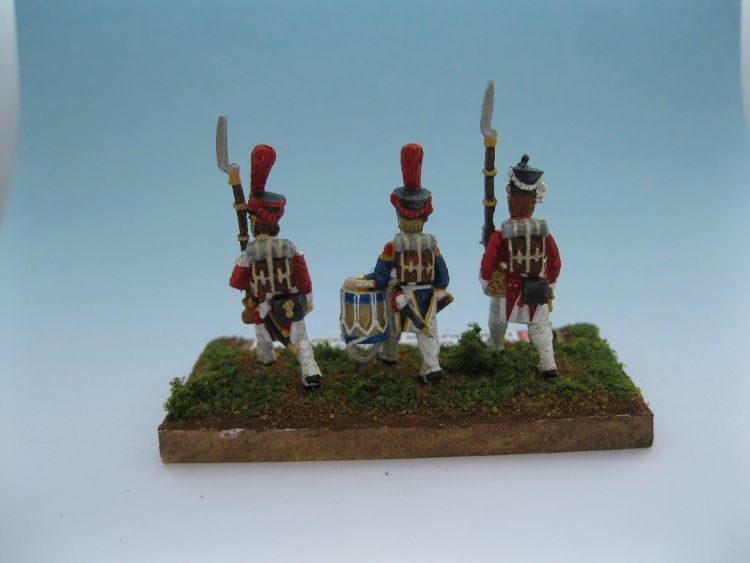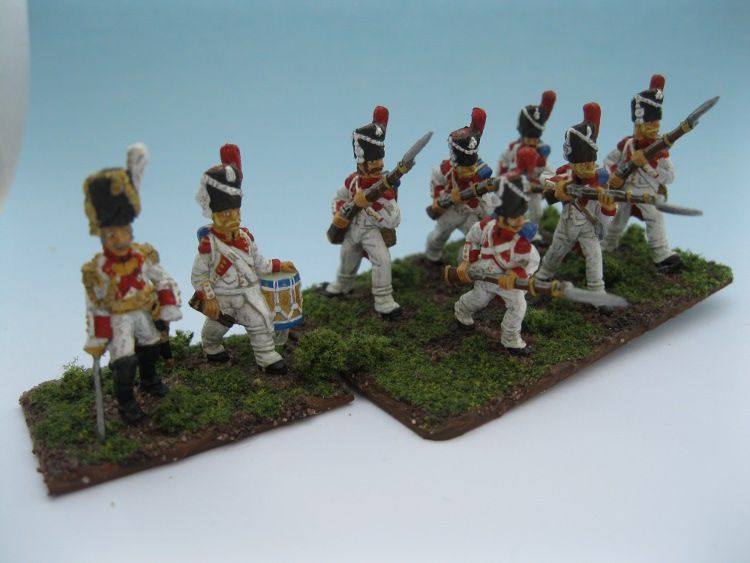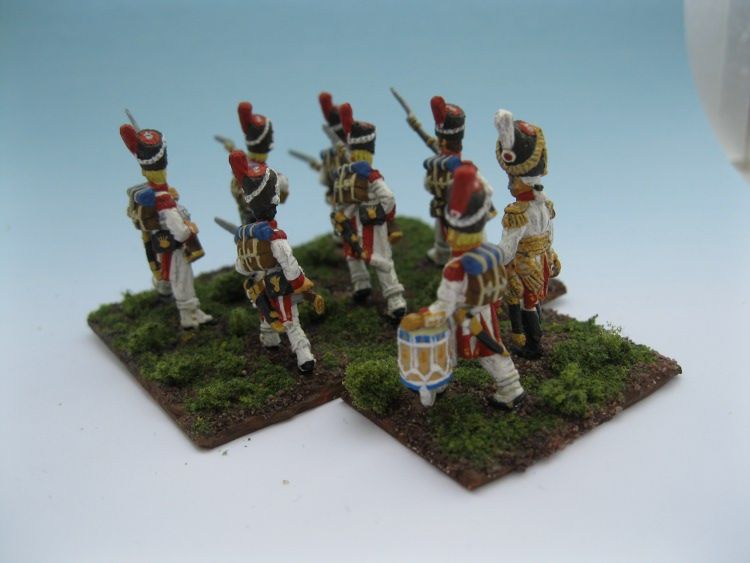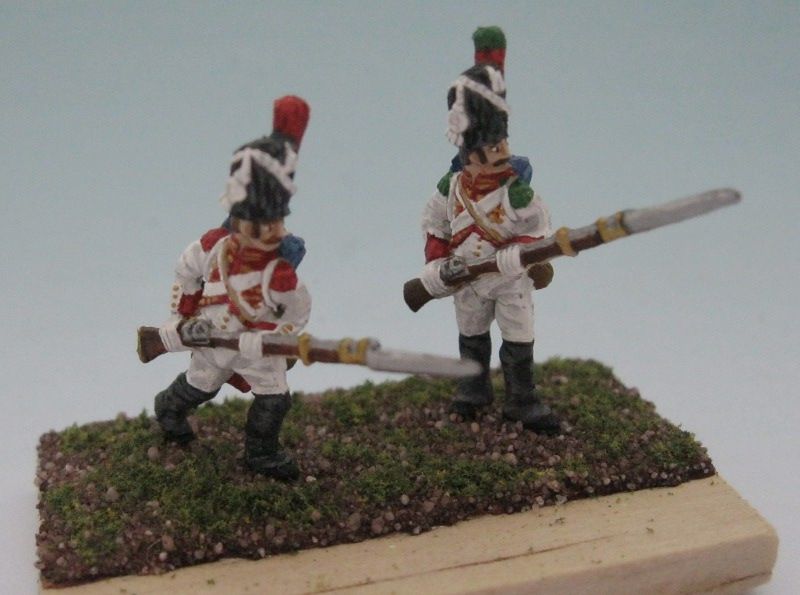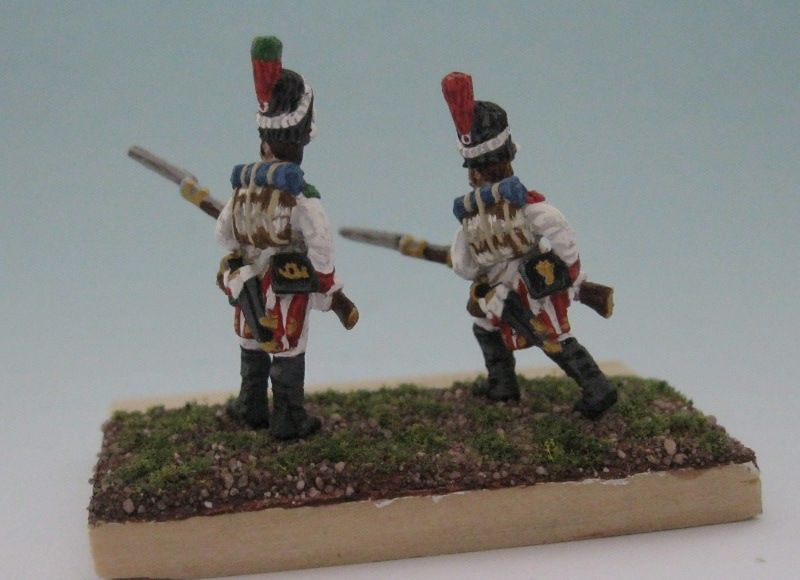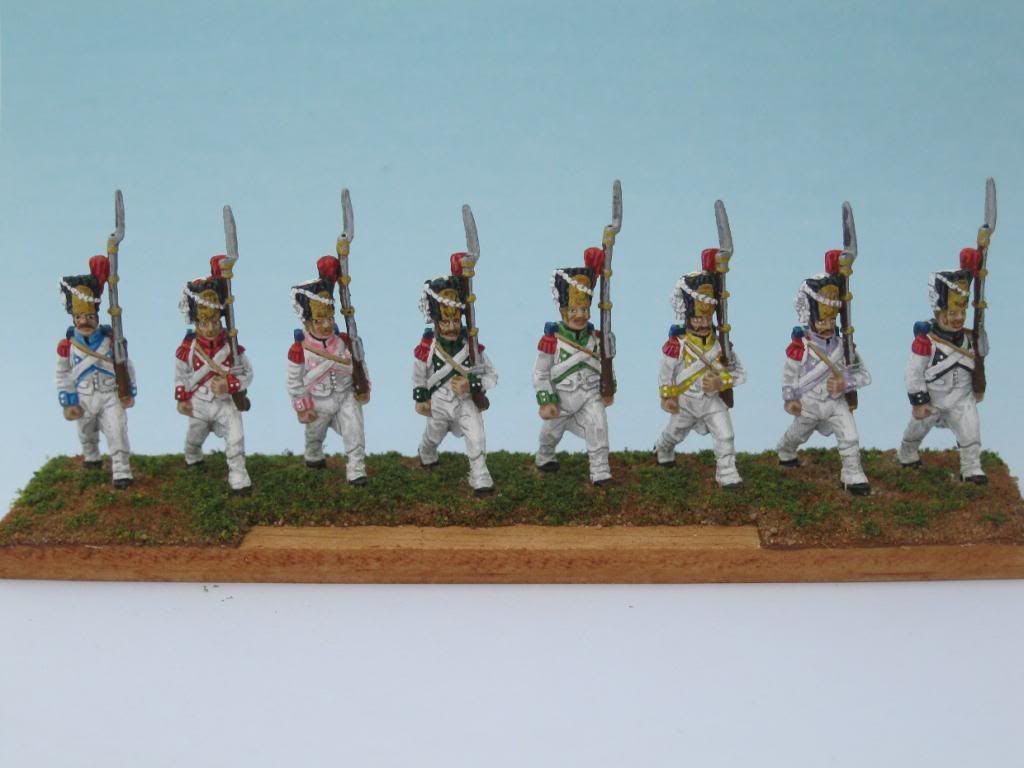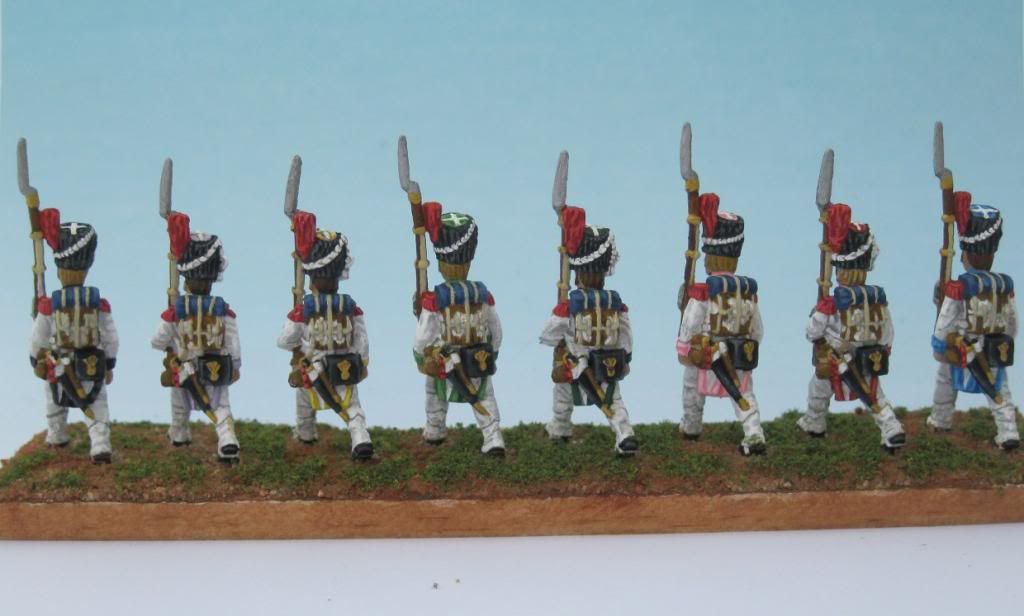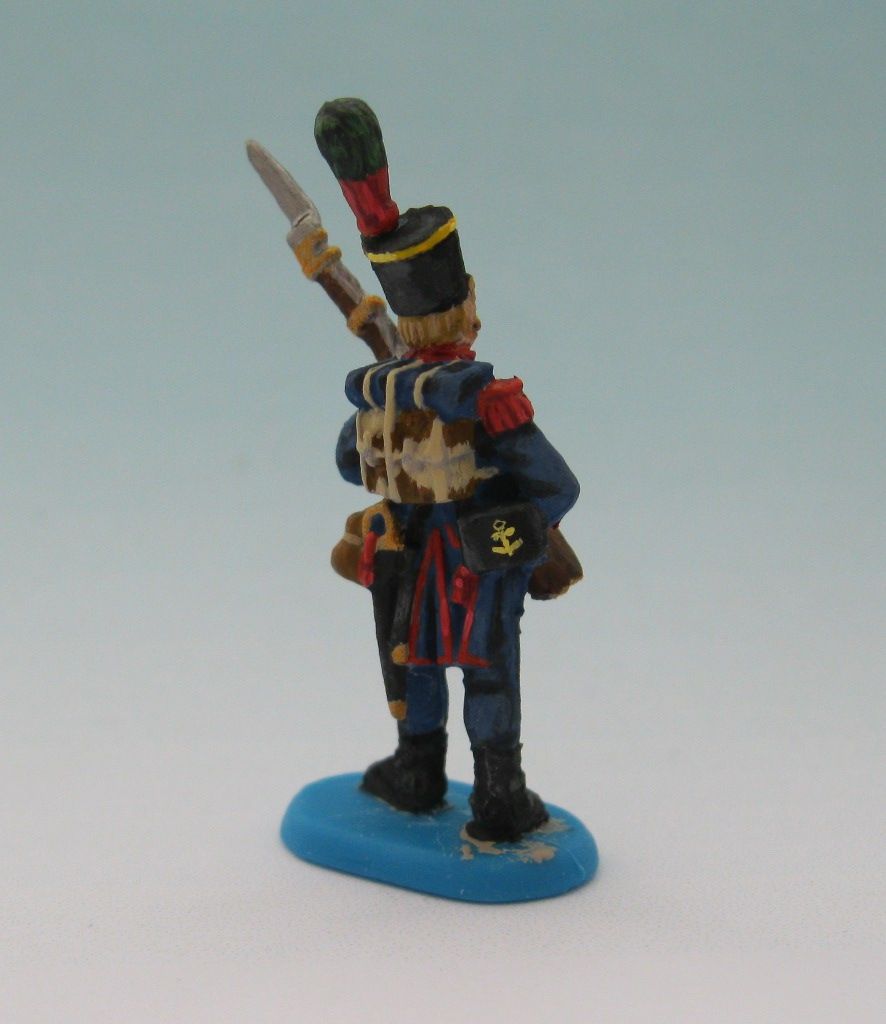At FIGZ (the 1/72 figure specific meeting in Goor, the Netherlands) I bought a set of 1806 Prussian hussars. I needed them for a little project with Peter (he mentioned it), but as I only needed one single mounted rider, I asked myself what to do with the rest.
Well - I made some recherche and found out that these hussars are dressed in a way that was very common in European armies throughout Europe in a period from around 1790 to 1806. It was astonishing to see that in many different countries, hussars just used exactly the same uniform! Differences were marginal - plumes worn on top or left instead of the right side and such things. So what about that set? You can see it here: http://www.plasticsoldierreview.com/Review.aspx?id=1453
Okay. So far so good. I painted my contribution for this special project of mine and for the first time I was somewhat angry about the figure. Now I took two others and watched out for nice examples of exotic uniforms. For the first of these two I decided for French death heads' hussars of 1792. Here's the result, of which I'm not too pleased:
What mostly upsets me are two things. First, the horse looks absolutely ugly. There's nothing elegant about it - it's a bloody plowhorse, not a warhorse!
Second: the hussar figures are absolutely disgusting, if you ask me. I really don't understand why plasticsoldierreview gave them such good grades. They have no face at all (the nose is almost not existing, the mustache looks like the man has a plank under his nose - and the rest of the details are missing. Maybe it's because this figure is small like a pygmy in comparizon to other 1/72 cavalrymen.
Having a look over the figures, I see that none of the sabres looks right. They're all bend in strange angles and directions. The cords are not straight in every case which might be realistic, but looks stupid on a miniature - and is also terrible when you try to paint straight lines. Honestly, I think that the result is more ugly then nice, but as I've already started to paint a swedish hussar as well, I guess I will paint a handful of others, just to display a bit the bandwith of varieties possible with this set of figures.
P.S.:
On Bennos' chat I recently argued about that set of figures and during the conversation, I said that I wondered if the chunky-style French hussars from Strelets wouldn't even look better than those HäT figures. I bought a handful of them back at the Figurenbörse in Herne in November 2010. So I just took one in order to paint it in the colours of the French Imperial 7th hussar regiment. And now look at this:
Well - the shading is not sufficiently visible on these photos. Maybe I make some other pictures when I have daylight conditions. But I guess everyone gets the point: this figure, although looking like a Napoleonic Gimli on the back of a shrunken horse (it's really an original, but for some strange reason, the horses look as being slightly smaller in scale than the riders...), has more expression in face, pose and everything then the HäT hussars. I don't know why I like this cartoony look so much, but this figure was a pleasure to paint.
Edit: August 13, 2011
I found it that the other figures from that Strelets set are really nice to paint as well. So I decided to paint the other ones also. I suppose that you've already seen the forthcoming two on the workbench - so where's number 2? The answer is here:
This nice guy represents a cavalryman from the ordinary company of the Westphalian guard hussars. The kingdom of Westphalia was a part of the Confederation of the Rhine states and consisted of territitories that were taken away from Prussia after their defeat in 1806.
Well. With all the other possible uniforms paintable with this nice comic-style set, I'll definitely soon buy a complete set of these Strelets hussars.
Update August 16, 2011:
Here we go again, this time with a hussar from Poland. Representing the 13th regiment of hussars, Duchy of Warsaw, here comes a regular hussar:
Splendid, unusual colours again. A real goodie, I think. Regarding the Duchy of Warsaw, there's some other varieties left to paint: the 10th hussar regiment and the reunited hussar regiment. I also found a nice polish ADC uniform in hussar style.
Oh - I recently had some visitors from Sweden, didn't I? This one is dedicated for you, a Bla regiment hussar:
Yellow and blue, very nice colours. I can't wait to show you the other Scandinavian hussar variation which already stands on my desk, but it cannot be shown for a reason... ;-)
Update August 24:
So here we go again. Today it's time to present you the fourth and final Strelets hussar figure. Well - at least the final one for the next few months. I'll surely continue with figures of this set after visiting the forthcoming figure trade show in Herne this years' November. Here we have an officer of the hussars of the grand duchy of Baden, another member of the Confederation of the Rhine:
The next example derived from HaTs' set of Prussian 1806 hussars is again a scandinavian hussar, this time from the kingdom of Denmark. This figure has a story. A while ago, we had one of these disputes about the historical accuracy of a painted Napoleonic figure at Bennos' forum. It was one of these discussions that tend to become very sarcastic at the end. Finally, someone stated that if he likes so, he would paint his hussars in pink, no matter if it's historically correct or not. I confess that I had a good laugh about this sentence, especially because I heared a similar statement somewhere else a while ago. This led me to the idea to make a recherche if any hussar regiment was really wearing pink uniforms, then buy myself some hussars and paint one in pink just to present it to the guys at the forum.
The recherche took me a while, but finally I found this splendid Danish hussar dressed in pink and light blue - just as if he had dropped out of a Pampers commercial! So I started to research for an adequate set, which brought me to the Prussian 1806 hussars that looked most suitable for this mission. I asked at the board if anyone possibly owned a set of them and wanted to swap one with me - but noone had one. Instead of that, my forum comrade Peter from Belgium told me that he found this idea of mine very funny and that he wanted to do a painting duel with me at Bennos'. So I bought a set of these HaT hussars at FIGZ 2010 and gave one sprue to Peter. And that's the story to which I referred with the very first sentence of this thread.
So here he is, the pink hussar!
It was a little bit difficult to have this figure similar to the one on the Knoetel page. At first, the Knoetel page shows the hussar equipped with a carbine. This was the easiest task - I took one of the spare arms and carved off the carbine, glued it onto the hussars side, done. The second detail was a bit more tricky. As you can see at the black French hussar from the start of this thread, they have some sort of roll at the backside of the saddle. The Knoetel page shows no such item - so I had to carve a saddle backside out of that stupid roll, which was a really annoying thing to do. The horse that I used for first practising if my idea worked ended up as a swedish hussar horse later.
The third and most difficult task was the fact that the hussar on the Knoetel page rode a grey horse. Oh my god. I never painted a horse like that. I prepainted it with and ivory colour (GW Bleached Bone), then added thin layers of off-white and finally put accents with thinned light grey (GW Fortress Grey). I corrected the result for several times, but to be honest I think that it still looks terrible. Whatever - here we finally have a pink hussar and that alone is enough for me to laugh a lot.
Update November 2011:
No, I've not been lazy, I simply hadn't got much time to put my focus on this matter again, but after so much time I have completed another hussar from the HaT 1806 set. This time, it's a Saxon hussar in the pre-1808 uniform. The white uniform with the light blue pelisse looks really gorgeous - unfortunately, the subtle light grey shading doesn't come through on the pictures. I must definitely find a better way to make my photos.
I hope you like this figure anyway. I still have some of them left - at the moment, I'm not quite sure how to paint them. I currently favour the Russian Zeltiy regiment, Chasseurs de Fischer and the French navy volunteer hussars. We'll see, won't we? ;-)
Thursday, July 21, 2011
Wednesday, July 13, 2011
Project: all varieties of pre-1812 French uniforms
Well - there's one specific set from HäT which displays (as far as I think) the pre-Bardin type of French uniform in the best way and that's the set 8095 French line infantry. The set 8166 1805-1812 “French line grenadiers” is technically an extension pack to this set which contains the eight additional stances that are necessary to complete the look of the grenadier battalions of that era.
This type of uniform wasn't only worn by the French core regiments, but also by many of the armies of nations allied with the French until 1813/1814. The pure range of painting possibilities astonisched me, so a while ago I decided to paint each and every variety possible with these sets.
The conditions for this project are:
- Only figures from HäT sets 8095 and 8166 and their parts are allowed, no external material or figure parts from other sets
- Modifications can be done within the sets – for example swapping heads or cutting/melting work that alters shako plates, cuffs, plume positions and other details into the required shape.
- No time limit or certain order of painting and posting
I know that in books and uniform tables many units are shown with gaiters, even with the Hessian type of gaiters that wears a tassle on top of it – and the soldiers in the set wear long trousers. Nevertheless, after reading some sources, talking with reenactors and looking on pictures of soldiers on campaign, I learned that on campaign, trousers were regularly worn above gaiters in order to prevent them from being worn-up too fast. Tassles were often stored in the packpack in order to prevent them from getting lost. So having this in mind, the long trousers are no problem at all. In some cases, I made some cutting work on the trousers in order to simulate gaiters with paint.
The aspect of units being on campaign also offers a good chance to vary with the standard pattern of uniforms and make lively mini-displays with units that have a more "active" look than the ones in parade dress. The most difficult guys in this project are the drummers. There are so many varieties of flamboyant uniforms, really great. But they are sometimes rather hard to paint because of all the flamboyant details on their jackets.
After having based most of my existing units, I now decided to create a complete catalogue of my project work on this place. Completed units are shown with full bases, not completed units have unfinished bases with placeholders that mark the position of the yet-to-be-painted soldiers.
Regiment representative plates show all sub-units that were either available to the specific regiments or available as a uniform pattern - for some, I did not have pictures of i.e. grenadier or voltigeur uniforms, for others, they simply didn't exist. I have also decided to paint drummer and officer versions only for one sub-cathegory (for example a fusilier drummer plus a grenadier officer etc.), because they mostly were only devided by epaulette and plume colours and - which is much worse - my supply of drummers and officers is always low because there are only 4 of each in every set.
To show as many details as possible, I made a front and a backside photo of every unit. So beware - a large catalogue is following this text...
French units
32nd regiment of the line, white uniforms
33rd regiment of the line, white uniforms
63rd regiment of the line
1st foreign regiment (tour d'Auvergne)
2nd foreign regiment (Isemburg)
Grenadiers (from left to right in the periods from 1805-1806, 1807-1808, 1809-1810, 1811-1812)
Voltigeurs (from left to right in the periods from 1805-1806, 1807-1808, 1809-1810, 1811-1812)
3rd foreign regiment (Irlandais)
4th foreign regiment (Prusse)
Chasseurs des montagnes
Piemontaise regiment
Tirailleurs du Po
Bataillon septinsulaire
Regiment Illyrien
Coastal guards
Sapper bombardiers and engineers
German Allies
Baden, lifeguard grenadier in field dress
Cleve-Berg, line infantry (left side) and national foot guards (right side)
Frankfurt, line infantry
Hanover, line infantry
Lippe-Detmold, line infantry
Westphalia, voltigeurs of the 7th line regiment
Wurzburg, line infantry
Wurzburg, voluntary hunters 1814
Italy and the mediterranian Allies
Kingdom of Italy, Velites of the guard
Kingdom of Italy, Conscripts of the guard
Kingdom of Italy, foot artillery of the guard
Kingdom of Italy, Guard grenadiers
Kingdom of Italy, line infantry fusiliers of all seven regiments
Kingdom of Italy, line infantry grenadiers of all seven regiments
Kingdom of Italy, fusiliers of the four light infantry regiments 1810-1812
Kingdom of Italy, light infantry carabiniers of the three regiments in 1809
Kingdom of Italy, colonial batallion
Kingdom of Italy, Coast guard
Kingdom of Italy, Guards of Milan
Croatia, 1st infantry regiment
Croatia, 3rd infantry regiment
Spain (French occupied)
Guard grenadier regiment of Joseph Napoleon
Regiment Joseph Napoleon
Jager regiment
1st-7th regiment of line infantry, fusiliers
Regiment Ile de Ré (left) and Walcheren (right)
Naples, light infantry
Naples foot velites, 1808, 1st regiment velite-chasseur and 2nd regiment velite-voltigeur
Naples guard grenadiers
Swiss regiments
1st infantry regiment
2nd infantry regiment
3rd infantry regiment
4th Swiss infantry regiment
Valais regiment
Others
Dutch grenadiers of the Old Guard
Kingdom of Holland, lifeguard grenadier regiment - grenadier and chasseur
Kingdom of Holland, line infantry, all 8 regiments
Grenadiers
Kingdom of Holland, 2nd light infantry regiment (early uniform)
Kingdom of Holland, Marines
This type of uniform wasn't only worn by the French core regiments, but also by many of the armies of nations allied with the French until 1813/1814. The pure range of painting possibilities astonisched me, so a while ago I decided to paint each and every variety possible with these sets.
The conditions for this project are:
- Only figures from HäT sets 8095 and 8166 and their parts are allowed, no external material or figure parts from other sets
- Modifications can be done within the sets – for example swapping heads or cutting/melting work that alters shako plates, cuffs, plume positions and other details into the required shape.
- No time limit or certain order of painting and posting
I know that in books and uniform tables many units are shown with gaiters, even with the Hessian type of gaiters that wears a tassle on top of it – and the soldiers in the set wear long trousers. Nevertheless, after reading some sources, talking with reenactors and looking on pictures of soldiers on campaign, I learned that on campaign, trousers were regularly worn above gaiters in order to prevent them from being worn-up too fast. Tassles were often stored in the packpack in order to prevent them from getting lost. So having this in mind, the long trousers are no problem at all. In some cases, I made some cutting work on the trousers in order to simulate gaiters with paint.
The aspect of units being on campaign also offers a good chance to vary with the standard pattern of uniforms and make lively mini-displays with units that have a more "active" look than the ones in parade dress. The most difficult guys in this project are the drummers. There are so many varieties of flamboyant uniforms, really great. But they are sometimes rather hard to paint because of all the flamboyant details on their jackets.
After having based most of my existing units, I now decided to create a complete catalogue of my project work on this place. Completed units are shown with full bases, not completed units have unfinished bases with placeholders that mark the position of the yet-to-be-painted soldiers.
Regiment representative plates show all sub-units that were either available to the specific regiments or available as a uniform pattern - for some, I did not have pictures of i.e. grenadier or voltigeur uniforms, for others, they simply didn't exist. I have also decided to paint drummer and officer versions only for one sub-cathegory (for example a fusilier drummer plus a grenadier officer etc.), because they mostly were only devided by epaulette and plume colours and - which is much worse - my supply of drummers and officers is always low because there are only 4 of each in every set.
To show as many details as possible, I made a front and a backside photo of every unit. So beware - a large catalogue is following this text...
French units
32nd regiment of the line, white uniforms
33rd regiment of the line, white uniforms
63rd regiment of the line
1st foreign regiment (tour d'Auvergne)
2nd foreign regiment (Isemburg)
Grenadiers (from left to right in the periods from 1805-1806, 1807-1808, 1809-1810, 1811-1812)
Voltigeurs (from left to right in the periods from 1805-1806, 1807-1808, 1809-1810, 1811-1812)
3rd foreign regiment (Irlandais)
4th foreign regiment (Prusse)
Chasseurs des montagnes
Piemontaise regiment
Tirailleurs du Po
Regiment Illyrien
Coastal guards
Sapper bombardiers and engineers
German Allies
Baden, lifeguard grenadier in field dress
Cleve-Berg, line infantry (left side) and national foot guards (right side)
Frankfurt, line infantry
Hanover, line infantry
Lippe-Detmold, line infantry
Westphalia, voltigeurs of the 7th line regiment
Wurzburg, line infantry
Wurzburg, voluntary hunters 1814
Italy and the mediterranian Allies
Kingdom of Italy, Velites of the guard
Kingdom of Italy, Conscripts of the guard
Kingdom of Italy, foot artillery of the guard
Kingdom of Italy, Guard grenadiers
Kingdom of Italy, line infantry fusiliers of all seven regiments
Kingdom of Italy, line infantry grenadiers of all seven regiments
Kingdom of Italy, fusiliers of the four light infantry regiments 1810-1812
Kingdom of Italy, light infantry carabiniers of the three regiments in 1809
Kingdom of Italy, colonial batallion
Kingdom of Italy, Coast guard
Kingdom of Italy, Guards of Milan
Croatia, 1st infantry regiment
Croatia, 3rd infantry regiment
Spain (French occupied)
Guard grenadier regiment of Joseph Napoleon
Regiment Joseph Napoleon
Jager regiment
1st-7th regiment of line infantry, fusiliers
Regiment Ile de Ré (left) and Walcheren (right)
Naples, light infantry
Naples foot velites, 1808, 1st regiment velite-chasseur and 2nd regiment velite-voltigeur
Naples guard grenadiers
Swiss regiments
1st infantry regiment
2nd infantry regiment
3rd infantry regiment
4th Swiss infantry regiment
Valais regiment
Others
Dutch grenadiers of the Old Guard
Kingdom of Holland, lifeguard grenadier regiment - grenadier and chasseur
Kingdom of Holland, line infantry, all 8 regiments
Grenadiers
Kingdom of Holland, 2nd light infantry regiment (early uniform)
Kingdom of Holland, Marines
Subscribe to:
Posts (Atom)





